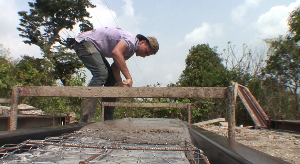Edition 23 - December 2006
Progress in formulating norms for earth constructions
Formulation of a "code of practice" for clay based structures began in Namibia in September. The "Habitat Research and Development Center" in the capital of Windhoek took the initiative, based upon the impact of the activities of the "Clay House Project" in Otjiwarongo, which has built more than 200 adobe houses during the past 10 years, and plans to build other 100 during the upcoming years. Olgalidia Jimenez, a Cuban cooperator who works in this center (HRDC), expects to have a first version of the codification ready for discussion in May of next year
As well, a work group to elaborate norms for construction of earth buildings has been created in Nicaragua. A first discussion round with authorities will be organized for April of 2007.
The EcoSur Network is actively providing consultancy in both activities.

Big demand for clay houses in Namibia
The Clay House Project in the city of Otjiwarongo, Namibia announced that they would receive applications for the clay houses for next year on the 17th of October. At 7:30 am. already up to 40 people were waiting with the money in their hands to make the down payment and little by little more people made their way to the CHP office. As the quota of the project for next year are just 40 houses, more than half of the aspirants had to be rejected, all of these being families with small income that had saved a considerable amount of money to qualify for a clay house. These houses are semi-subsidized although the subsidy is getting smaller every year. The project is desperately looking for financing to enlarge their activities.

First successful firing of bricks in vertical shaft brick kiln
 A
few decades ago in China a new type of continuous kiln was invented.
While the traditional continuous kilns (Hoffmann type) require a high
investment, the Chinese kilns are relatively easy to build and were
copied in India a few years ago. For the past three years SofoNic has
been working on adaptation of the vertical shaft brick kiln to the
conditions of Latin America. The principal aspect is that in China
and India the firing is done with coke, while in Nicaragua the firing
is with wood.
A
few decades ago in China a new type of continuous kiln was invented.
While the traditional continuous kilns (Hoffmann type) require a high
investment, the Chinese kilns are relatively easy to build and were
copied in India a few years ago. For the past three years SofoNic has
been working on adaptation of the vertical shaft brick kiln to the
conditions of Latin America. The principal aspect is that in China
and India the firing is done with coke, while in Nicaragua the firing
is with wood.
By Kurt Rhyner
Read more: First successful firing of bricks in vertical shaft brick kiln
Housing plans in Venezuela
 In
a visit to the "Bolivarian Republic of Venezuela" we where able
to confirm that there is a great effort to carry out the ambitious
plans of construction of housing and social buildings. Fenavip, the
historic Colombian partner of the EcoSouth network is involved in
various locations and as usual uses a great variety of EcoMaterials.
In
a visit to the "Bolivarian Republic of Venezuela" we where able
to confirm that there is a great effort to carry out the ambitious
plans of construction of housing and social buildings. Fenavip, the
historic Colombian partner of the EcoSouth network is involved in
various locations and as usual uses a great variety of EcoMaterials.
By Kurt Rhyner
A powder that makes miracles
 The brick-maker prepares
the next burning in his rustic oven, but this time there is a
difference in his routine: into the moist clay he will mix a very
fine white powder given to him by a young researcher from CIDEM who
is visiting his workshop. The young man explains that implementation
of this material, baptized by a countryside brick-maker as PROVID,
will bring about significant savings in the production process,
because of its properties as a fluxing material. While the
brick-maker had his doubts, his curiosity stimulated his trying the
new product.
The brick-maker prepares
the next burning in his rustic oven, but this time there is a
difference in his routine: into the moist clay he will mix a very
fine white powder given to him by a young researcher from CIDEM who
is visiting his workshop. The young man explains that implementation
of this material, baptized by a countryside brick-maker as PROVID,
will bring about significant savings in the production process,
because of its properties as a fluxing material. While the
brick-maker had his doubts, his curiosity stimulated his trying the
new product.
By Prof. Dr. Fernando Martirena



